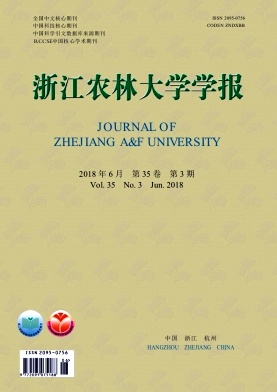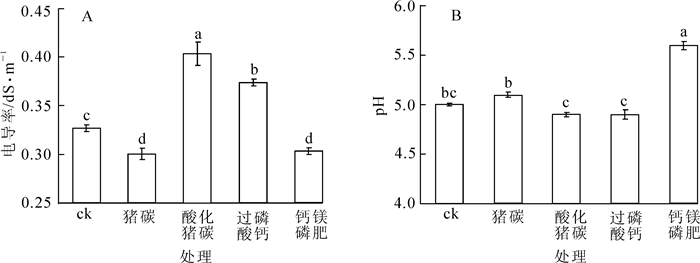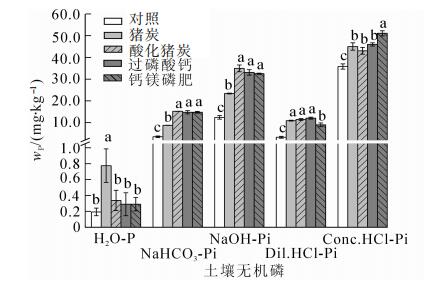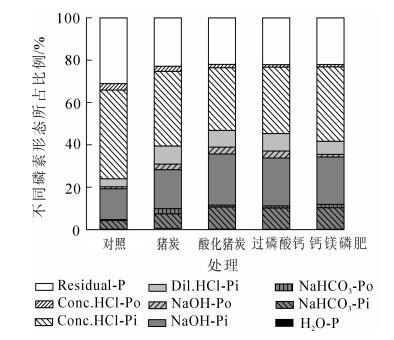-
磷是植物生长发育的必需营养元素[1],植物对磷的吸收主要来源于土壤。中国农业土壤中虽然磷含量较高,但大部分以难溶态存在,农业经营中常常需要通过持续施用磷肥保持土壤“不缺磷”的状态。化学磷肥的当季利用率通常为10%~20%[2],这造成磷肥的持续施用使土壤中磷大量积累,而过剩的磷会随地表径流或水土流失等途径进入水体环境,导致水体富营养化[3]。生物质炭是由农林废弃生物质在高温缺氧条件下热解制成,是一种新型、绿色的土壤改良剂。磷在生物质热解过程中基本被保留下来,将生物质炭施入土壤后,可释放磷并为植物所利用[4]。生物质炭的施用可显著降低土壤对磷的吸附从而提高有效磷的含量[5-6],减少农田磷损失[7]并为土壤微生物提供良好的生存环境[8]。通过物理、化学等方法改性生物质炭,可以进一步改善其表面结构和吸附能力[9]。与原始生物质炭相比,氯化铁改性后的生物质炭对土壤中有效磷的吸附作用有极大提高[10]。冯兆滨等[11]研究表明:部分酸化磷矿粉可以提高低品位磷矿粉的有效利用率。目前,利用强酸改性生物质炭进而改变其理化性质的相关研究较少,利用酸化处理生物质炭对土壤磷含量及转化的研究更鲜见报道。此外,以往对生物质炭的研究大多以植物源生物质炭为对象,对动物源生物质炭的研究较少。据统计,中国生猪出栏总数达6.6亿头·a-1[12],按照生猪3%的正常死亡率,产生的病死猪的数量约2 000万头·a-1,若处置不当,则会产生一系列生态环境以及食品安全问题。随着养殖业的发展,病死猪的数量必然会激增,将病死猪通过热解炭化技术制成生物质炭突破了传统思维方式,一方面生产成本低廉、处理效率较高(整猪投入热解炉,无需粉碎),可实现批量生产;另一方面,灭菌效果彻底,杜绝了病死猪可能造成的病毒感染及环境污染等问题。热解炭化产生的猪炭含有较高的有机物质和养分,可以作为土壤改良剂或者肥料加以利用。研究表明:猪炭施用能够增加蔬菜的产量[13],减少温室气体二氧化碳和一氧化氮排放[13],降低土壤中氨挥发[13-15]。YANG等[16]探讨了猪炭对土壤中重金属形态转化和烟草Nicotiana tabacum生长的影响,发现可以有效降低土壤重金属的有效性,而且土壤磷质量分数高达8.3%。目前对于猪炭及其改性产物对土壤磷质量分数及其形态转化影响方面的研究仍处于空白阶段。因此,本研究以病死猪为生物质原料,在650 ℃下热解制备初始生物质炭,进而利用硝酸浸渍酸化得到改性的生物质炭。同时,以未经处理的猪炭、过磷酸钙和钙镁磷肥为对比材料,研究酸化猪炭对土壤磷质量分数及形态转化的作用,并对比酸化猪炭与常规化学磷肥对土壤中磷形态转化的不同影响,为利用生物质炭提高土壤磷有效性的可行性提供理论依据。
HTML
-
供试土壤采自浙江省杭州市临安区湖塘下村(30°15′N,119°42′E)蔬菜种植基地邻近的新垦空置地块。土壤类型为红壤,黏土矿物以高岭石为主,酸性,盐基饱和度低。采集表层土(0~20 cm),剔除土壤样品中的杂物,风干过2 mm筛后备用。供试猪炭是利用热解装置将病死整猪在650 ℃缺氧条件下热解炭化后磨碎成细小颗粒。准确称取80.0 g猪炭浸泡于80.0 mL体积分数为65%~68%的浓硝酸中搅拌均匀,静置7 d后,将固液混合态的酸化猪炭置于65 ℃烘箱内烘干,即得酸化猪炭。供试过磷酸钙(五氧化二磷质量分数≥12.0 g·kg-1)和钙镁磷肥(五氧化二磷质量分数≥12.0 g·kg-1)均购自市场,所有材料均研磨过2 mm筛后备用。供试土壤和试验材料的基本理化性质见表 1。
材料 w全磷/(g·kg—1) pH值(H20) σ/(dS·m-1) w有机碳/(g·kg—1) 供试土壤 0.099 5.0 0.3 0.5 猪炭 81.300 10.1 3.2 25.8 酸化猪炭 52.300 3.0 12.4 26.7 过磷酸钙 52.100 2.1 5.3 钙镁磷肥 52.900 9.6 2.9 Table 1. Chemical properties of the soil and amendments used in the experiment
-
称取1.5 kg过筛土装入塑料盆(直径为15 cm,高为13 cm),以土壤中磷肥适宜施用量为参照,分别将质量分数为1.0 g·kg-1用量(1.56 t·hm-2)的酸化猪炭、猪炭、过磷酸钙和钙镁磷肥与土壤样品混合均匀。以空白土壤为对照(ck),共5个处理,重复3次·处理-1。按田间持水量的70%加入去离子水,土壤隔3 d补水1次,于25 ℃下连续培养210 d后,采集土壤样品,风干后分别过2.000和0.149 mm筛进行检测分析。
-
根据国际生物质炭协会(IBI)标准方法[17],供试生物质炭的电导率(EC)和pH值均采用m(固体):m(水)=1.0:20.0,充分搅拌并静置后分别用电导率仪(DDS-307型,上海虹益仪器仪表有限公司)和FE20型pH计测定。生物质炭的全磷质量分数用酸溶-钼锑抗比色法(700 nm)测定,有效磷质量分数使用碳酸氢钠浸提法(Olsen法)测定[18],碱度利用返滴定法[16]测定。总碳质量分数用元素分析仪(Flash EA1112, Thermo Finnigan, 意大利)测定,有机碳质量分数用总碳质量分数减去无机碳质量分数而得。比表面积(BET)通过比表面积分析仪(TristarII3020, Micromeritica Instrument Corporation, 美国)在77 K氮气条件下测定。利用电子扫描显微镜(Sirion-100, FEI, 波兰)观察2种生物质炭的孔隙结构,并利用X射线能量色散谱仪(X-ray Energy Dispersive Spectrometry, EDS)测定其化学元素组成。
-
土壤电导率按m(土):m(水)=1.0:5.0,用电导率仪测定;pH值采用m(土):m(水)=1.0:2.5,用pH计测定。土壤全磷采用酸溶-钼锑抗法测定,有机碳质量分数用重铬酸钾氧化外加热法测定[18]。
土壤磷形态分级采用SUI等[19]修正的TIESSEN等[20]改进的Hedley磷分级方法。分别逐级加入去离子水,0.5 mol·L-1碳酸氢钠溶液(pH 8.5),0.1 mol·L-1氢氧化钠溶液,1.0 mol·L-1稀盐酸和12.0 mol·L-1浓盐酸进行浸提实验。其中碳酸氢钠、氢氧化钠和浓盐酸提取态磷又分为无机态和有机态磷,总磷质量分数用过硫酸钾在121 ℃下消煮而得,有机磷质量分数为总磷质量分数与无机磷质量分数之差。这样依次得到水溶态磷(H2O-P),碳酸氢钠提取态磷(NaHCO3-Pi和NaHCO3-Po),氢氧化钠提取态磷(NaOH-Pi和NaOH-Po),稀盐酸提取态磷(Dil.HCl-Pi),浓盐酸提取态磷(Conc.HCl-Pi和Conc.HCl-Po)和残留态磷(Residual-P)。各级磷质量分数均采用钼蓝比色法[18]测定。
-
数据采用Excel 2013和SPSS 17.0软件进行处理、分析,用单因素方差分析(one-way ANOVA)和Duncan’s多重比较进行不同处理之间的显著性评价,用Pearson相关系数进行不同形态磷之间的相关性检验,用Origin 8.0软件做图。
1.1. 试验材料
1.2. 试验设计
1.3. 生物质炭性质测定
1.4. 土壤性质及磷形态分析
1.5. 数据分析
-
猪炭(图 1A)比酸化猪炭(图 1B)具有更明显的孔隙结构和更高的比表面积(表 1),可能是由于硝酸酸化过程中,猪炭本身的孔隙结构被破坏或堵塞。对生物质炭进行X射线能谱分析,可知猪炭(图 1C)及酸化猪炭(图 1D)均含有较多的碳、氧、磷、钾、钙、铁等元素,矿质元素质量分数较高。其中猪炭磷和钙的质量分数分别高达86.1和150.7 g·kg-1,而酸化猪炭磷和钙分别为36.0和85.4 g·kg-1。该结果可能是酸化过程中部分元素溶于酸溶液所致。
-
由图 2A可知:不同处理对土壤电导率(EC)变化的影响不同。猪炭和钙镁磷肥处理下电导率较对照(ck)显著(P<0.05)降低,而酸化猪炭和过磷酸钙处理下电导率较对照分别提高了24%和14%。对于2个施炭处理,酸化猪炭处理下比猪炭处理下电导率值提高了34%。由图 2B可知,钙镁磷肥处理下土壤pH值显著(P<0.05)提高,高达5.6,其余各处理的pH值较对照均没有显著变化。由本试验可知:1.0 g·kg-1施用量下,猪炭和酸化猪炭处理下土壤电导率均有显著(P<0.05)变化,其中酸化猪炭提高量较大,两者pH值较对照均没有显著(P>0.05)变化,猪炭处理较对照有升高趋势,且显著(P<0.05)高于酸化猪炭处理。
-
由图 3可知:不同处理下土壤无机磷质量分数占总磷质量分数的64.5%~74.1%,是土壤中磷最主要的组成部分[6]。其中,H2O-P在无机磷总量中比例最低,猪炭处理下土壤中H2O-P质量分数显著(P<0.05)高于其余各处理。NaHCO3-Pi在无机磷总量中占6.3%~14.5%,各处理均显著(P<0.05)高于对照。其中,猪炭和酸化猪炭处理的NaHCO3-Pi质量分数分别是对照的2.5倍和4.5倍,酸化猪炭处理与过磷酸钙、钙镁磷肥处理相比无显著差异。NaOH-Pi在各形态无机磷中所占比例较高,为22.5%~33.3%,其质量分数变化趋势与NaHCO3-Pi一致。其中,猪炭处理NaOH-Pi质量分数为23.40 mg·kg-1,约为对照的2倍。酸化猪炭处理NaOH-Pi质量分数高达34.98 mg·kg-1,约为对照的3倍,而与过磷酸钙和钙镁磷肥处理无显著差异。Dil.HCl-Pi质量分数为无机磷总量的5.9%~12.3%,各处理均显著(P<0.05)高于对照,其中,猪炭(10.91 mg·kg-1),酸化猪炭(11.44 mg·kg-1)和过磷酸钙(12.06 mg·kg-1)处理间无显著差异,约为对照(3.24 mg·kg-1)的3.5倍,而钙镁磷肥处理在所有处理中最低。Conc.HCl-Pi在各形态无机磷中比例最高,为41.0%~65.0%。猪炭(45.01 mg·kg-1),酸化猪炭(43.03 mg·kg-1),过磷酸钙(45.98 mg·kg-1)处理均显著高于对照(35.83 mg·kg-1),而钙镁磷肥处理在所有施肥处理中最高,为51.09 mg·kg-1。总体而言,施炭处理下土壤中各形态无机磷均显著(P<0.05)提高,与2个化学磷肥处理有相似的提高趋势。
-
如图 4所示:各处理下土壤有机磷质量分数均较低,有机磷质量分数占总磷的0.5%~3.3%,各形态的有机磷质量分数均不超过5.00 mg·kg-1。各施肥处理下NaHCO3-Po质量分数相比于对照均有提高的趋势,但效果不显著。对于NaOH-Po质量分数,酸化猪炭和过磷酸钙处理分别为4.75和4.87 mg·kg-1,比对照提高5.1和5.3倍,而猪炭处理和钙镁磷肥处理与对照没有显著差异。各处理下Conc.HCl-Po质量分数无显著差异,但有降低的趋势。土壤中Residual-P质量分数是总磷的29.0%~31.0%,与对照相比各处理均显著提高,但处理间无显著性差异。总体上,酸化猪炭在提高土壤有机磷和残留态磷质量分数方面优于猪炭,且与2个化学磷肥处理无显著差异。
-
土壤磷可分为活性磷、中稳活性磷和非活性磷3种。活性磷包括H2O-P,NaHCO3-Pi和NaHCO3-Po,是植物可以有效利用的那部分磷;中稳活性磷包括NaOH-Pi和NaOH-Po是植物的潜在磷源;非活性磷包括Dil.HCl-Pi,Dil.HCl-Po,Conc.HCl-Pi和Residual-P,一般不被植物吸收利用,也不会被溶解释放。由图 5可知:与对照相比,其他处理NaHCO3-Pi占总磷百分比均明显升高,这与图 3结果一致。此外,活性磷百分比也明显提高,相比对照提高107.1%~149.3%,4个处理之间的变化没有显著差异(图 6)。添加生物质炭和化学磷肥后,土壤中稳活性磷占总磷的百分比均有不同程度的提高,较对照提高36.2%~77.2%,其提高程度为酸化猪炭>过磷酸钙>钙镁磷肥>猪炭。与中稳活性磷相反,不同处理下各形态的非活性磷所占总磷百分比较对照均有所下降,其中酸化猪炭处理下降23.5%,显著(P<0.05)高于猪炭(13.4%),过磷酸钙(21.2%)和钙镁磷肥(19.2%)的下降量。
-
用不同形态磷占总磷的百分比做相关性分析,若任意2种形态磷百分比之间呈负相关关系,则说明这2种形态的磷之间可以相互转化[21]。由表 2可知:H2O-P和NaHCO3-Po与其余各形态磷之间均没有显著相关性;NaHCO3-Pi与Conc.HCl-Pi,Residual-P;NaOH-Pi与Conc.HCl-Pi,Conc.HCl-Po,Residual-P;NaOH-Po与Conc.HCl-Pi之间均呈显著(P<0.01)负相关,这表明土壤磷形态的转化主要发生在活性磷(NaHCO3-Pi)与非活性磷(Conc.HCl-Po和Residual-P),中稳活性磷(NaOH-Pi和NaOH-Po)与非活性磷(Conc.HCl-Po和Residual-P)之间。由图 7可见:土壤中非活性磷与活性磷、中稳活性磷之间存在显著(P<0.01)负相关。这说明添加不同材料后,土壤中的稳定形态磷仍然保持比较低的比例。
不同形态磷 NaHCO3-Pi NaHCO3-Po NaOH-Pi NaOH-Po D.HCl-Pi C.HCl-Pi C.HCl-Po Residual-P H2O-P -0.264 0.172 -0.120 -0.141 0.296 0.104 0.277 -0.145 NaHCO3-Pi 0.001 0.930** 0.422 0.590 -0.859** -0.505 -0.875** NaHCO3-Po -0.111 0.168 0.157 -0.096 -0.339 0.170 NaOH-Pi 0.243 0.565* -0.786** -0.557** -0.847** NaOH-Po 0.627** -0.693** 0.003 -0.463 D.HCl-Pi -0.781* -0.195 -0.802** C.HCl-Pi 0.253 -0.798** C.HCl-Po 0.477 说明:*代表在0.05水平上相关显著;**代表在0.01水平上相关显著 Table 2. Correlation coefficients among different fractions P in the soils
2.1. 酸化处理前后猪炭的基本理化性质
2.2. 土壤电导率和pH值
2.3. 土壤无机磷质量分数
2.4. 土壤有机磷和残留态磷质量分数
2.5. 土壤中各形态磷百分比变化
2.6. 土壤各形态磷占总磷百分比之间的相关性
-
土壤电导率包含了反映土壤性质的丰富信息,是衡量土壤肥力的参考指标之一。通常可以通过测定土壤电导率来估测土壤盐分含量[22-23]。本研究发现:将酸化猪炭和过磷酸钙加入土壤后,土壤电导率显著提高,这可能是由于猪炭在酸化过程中引入了大量的硝酸根离子(NO3-),过磷酸钙中含有较多的硫酸根离子(SO42-),施入土壤后盐分含量升高,从而引起电导率提高。本试验中,除钙镁磷肥处理土壤pH值显著提高外,其余各处理较对照均无显著变化。钙镁磷肥的施用可以提高土壤pH值且与施用量呈正相关[24]。YANG等[16]研究表明:在酸性土壤中添加质量分数为25.0和50.0 g·kg-1的猪炭均可显著提高土壤的pH值。本研究施用1.0 g·kg-1猪炭后,土壤pH值有升高趋势,主要是因为生物质炭本身具有较大的碱度,含有较多的盐基离子和碱性物质[25]。猪炭经硝酸浸渍处理后,其表面的碱性官能团被中和,所以酸化猪炭处理下pH值较猪炭处理低。研究表明:土壤电导率与磷在土壤中的空间分布变化具有一定联系,在评估土壤中不同形态磷质量分数时可以提供一些参考[26],土壤pH值可以通过改变离子的种类、强度及微生物活动而间接对土壤中磷形态的转化造成影响[27]。
-
将有机或无机外源磷肥施入土壤后可显著提高各形态磷含量[28],其中仅有少量磷可被植物直接吸收,绝大部分以缓效态和难溶态(HCl-P和Residual-P)存在[29]。H2O-P是土壤中活性最高的磷组分,但一般测定值较小[30];施用猪炭可显著提高土壤中的H2O-P,一方面可能是因为猪炭处理本身磷素施入量高于其他处理,另一方面可能是因为猪炭含有更加丰富的孔隙结构,施入土壤后可以为微生物提供良好的生活环境[31],微生物作用可使土壤中难以被植物利用的有机磷向易被植物利用的H2O-P转化[32]。NaHCO3-P主要是吸附在土壤表面活性较强的无机磷和易于快速矿化分解的有机磷[33]。其中,NaHCO3-Pi较高,可能是H2O-P向较稳定的NaHCO3-P转化[34],也可能是由于酸性土壤中难以被植物利用的磷向更易被植物吸收利用的无机磷转化所致[35]。NaOH-P主要是与土壤铁铝氧化物及腐殖质等通过吸附作用结合在一起的磷,是植物的潜在磷源[29]。本研究以南方红壤为对象,其有机质质量分数较低,且因脱硅富铝化与生物富集作用影响,土壤中有较高的铁和铝[36],因此易与铁和铝化合物结合的NaOH-Pi质量分数较高[33],而易与腐殖酸结合的NaOH-Po质量分数较低。各处理与对照相比土壤中NaOH-Pi质量分数均显著提高。相关性分析结果表明,土壤中NaOH-Pi与NaHCO3-Pi的质量分数呈显著正相关,可能是由于土壤中NaOH-P库对活性磷具有补充作用,在磷供应中具有缓冲效果[37]。土壤中HCl-P和Residual-P呈显著负相关,可能由于HCl-P和Residual-P转化为NaOH-Pi[29]。研究表明:随着腐熟鸡粪、解磷菌肥和复合肥的施入,土壤中HCl-Pi和HCl-Po较对照均显著升高,且质量分数随施肥量的增加而增加[38],而Residual-P质量分数也随施肥时间和施用量逐渐升高[29]。NEGASSA等[39]研究表明:磷肥的外源添加形式对土壤中磷组分比例变化的影响不大。本研究中,施用酸化猪炭对各磷形态的影响与相同施磷量下2种化学磷肥处理相比差别不大,从某种意义上讲,可以用酸化猪炭来替代过磷酸钙和钙镁磷肥的施用。
-
各处理均可显著提高土壤活性磷和中稳活性磷的质量分数,降低非活性磷的质量分数,该结果与LI等[29]研究一致。相关性分析表明,非活性磷所占总磷百分比与活性磷和中稳活性磷所占百分比均呈显著负相关,这说明将2种生物质炭和2种化学磷肥施入土壤后,非活性磷被活化而转化为活性磷和中稳活性磷[21]。酸化猪炭处理下中稳活性磷的增加量和非活性磷的降低量均显著高于2种化学磷肥和猪炭处理,一方面可能是因为酸化猪炭的施用可以提高土壤中解磷微生物的数量,解磷微生物分泌的有机酸可与土壤中钙离子(Ca2+),铁离子(Fe3+)和铝离子(Al3+)等发生螯合或络合作用,从而将难溶态磷酸盐转化为可溶态[40]。另一方面,酸化猪炭的施用可能会提高土壤中磷酸酶尤其是酸性磷酸酶的活性,进而促进磷的活化[29, 41]。高比表面积的沸石可以通过吸附Ca2+,Fe3+和Al3+等阳离子活化磷矿粉[42],羧基、酚羟基等活性官能团会与难溶的磷酸盐发生络合反应[29],生物质炭具有巨大的比表面积、丰富的孔隙结构和含氧官能团,这些特殊性质使它对磷活化也具有一定促进作用。生物质炭还可以通过改变土壤电导率和pH值等基本理化性质影响磷的分布和转化。谢莹等[27]研究表明:土壤无机磷和残留态磷质量分数与电导率显著正相关。本研究中,土壤电导率与中稳活性磷质量分数显著正相关(R2=0.611,P<0.05),可能由于土壤盐度通过调节微生物种类和活性影响土壤中磷的分解和释放速率,从而提高中稳活性磷的质量分数[43]。此外,土壤pH值对磷形态的变化具有一定影响,一方面是因为pH值升高可提高土壤表面可变负电荷,降低磷吸附,进而提高土壤有效磷质量分数[44];另一方面可能是由于pH值升高,土壤中氢氧根离子(OH-)可以与被束缚的磷酸二氢根(H2PO4-)竞争吸附点位,从而释放磷[45]。
3.1. 不同处理对土壤电导率和pH的影响
3.2. 不同处理对土壤中不同形态磷质量分数的影响
3.3. 不同处理对土壤中磷形态转化的影响
-
施用猪炭和酸化猪炭均可显著(P<0.05)提高土壤电导率,其中酸化猪炭提高量较大,而两者pH值较对照均没有显著变化。施用酸化猪炭和猪炭后土壤中各形态无机磷均显著(P<0.05)提高,且与2个化学磷肥处理有相似的提高趋势。另外,酸化猪炭在提高土壤有机磷和残留态磷质量分数方面优于猪炭,且与2个化学磷肥处理无显著差异。土壤中各个形态磷质量分数随各种含磷添加物的施入均有所提高,施用酸化猪炭对中稳活性磷比例的提高和非活性磷比例的降低效果均明显优于猪炭和化学磷肥处理。酸化猪炭对土壤中磷的活化效果优于猪炭,这表明生物质炭的酸化过程对提升土壤磷素含量具有较好效果。综上所述,在施磷量相同的情况下,酸化猪炭对土壤磷含量的提高效果堪比化学磷肥,说明用酸化猪炭来替代过磷酸钙和钙镁磷肥的施用具有可行性。这不仅可以消除病死猪处理不当对生态环境可能造成的危害,还可以改善土壤肥力,减少化肥施用量。





 本站查看
本站查看









 DownLoad:
DownLoad: